
Cinderella Castle, Spaceship Earth, Earful Tower and now Mickey’s Sorcerer’s Hat — all of these structures have one thing in common. These are the icons that represent the various Walt Disney World theme parks.
The word “icon” has its roots in early Eastern Christianity. Icon-paintings of the time depicted a holy object or being such as the cross, Jesus, Mary, angels, and saints. The mere sight of one of these paintings, or icons, would instill a feeling of spirituality within an individual.
As the centuries marched on, the meaning of the word icon was expanded. Today, an icon can be a two or three dimensional likeness that represents an object, idea, or place by virtue of a resemblance or analogy to it. Or it can be an actual object that represents a greater whole. Marketing firms know this well and use icons to sell their goods and products. Beginning in 1955, this sight of Sleeping Beauty Castle, the icon of Disneyland, made us long to visit the Happiest Place on Earth.
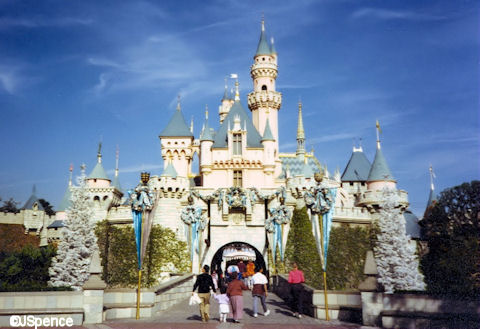

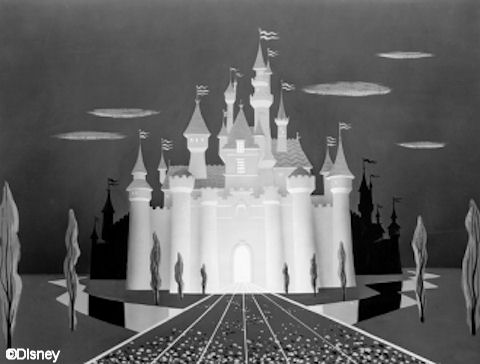
When the Imagineers began thinking about Disney’s Animal Kingdom in 1989, they knew this new park would also need an icon to represent it to the world. But what would this be?
The Tree of Life was the answer. This icon would impart the message of the Animal Kingdom with a single glance. A gigantic tree would represent the abundant plant life of the planet and the many creatures that would be carved into its bark would symbolize the vast array of animals that call Earth home. However, the Tree of Life did not start out as the mighty structure that it would eventually become. Early designs called for a tree about 50 feet high that would act as a playground for children. As ideas for the tree began to evolve and grow, a viewing platform was envisioned within its branches where guests could survey Safari Village (now Discovery Island) and the environs beyond.
In this early concept drawing, you can see people climbing up into the Tree of Life (right side of the picture).

As the tree continued to grow in concept, so did the Imagineers’ ideas. One early plan called for a fine eatery to be housed beneath the tree and called Roots Restaurant. But this idea was eventually abandoned in favor of a theatrical show. However, placing a restaurant or a theater beneath such a large structure would create engineering problems. The tree needed to withstand hurricane force winds and a large room built directly under the tree’s trunk would make constructing a proper foundation difficult. The idea for the Tree of Life came to a standstill until a solution could be found.
An answer to the problem came from one of the Imagineers who was home watching an educational television program about off-shore oil drilling in the Gulf of Mexico. Upon seeing the type of structure used in this endeavor, he knew immediately that the Tree of Life could move forward. The free-span oil-drilling platform offered a wide base, large enough to house a good-sized room, a narrow center section for the tree’s trunk, and an expanding top section capable of supporting branches. After preliminary studies were made, a drilling platform was purchased and shipped to Tampa. From there it was trucked to the Animal Kingdom and erected onsite. This next picture shows a model of the structure.
(I received a comment from a reader who tells a slightly different story about the origins of the Tree of Life. Please see John Katok’s comment below.)
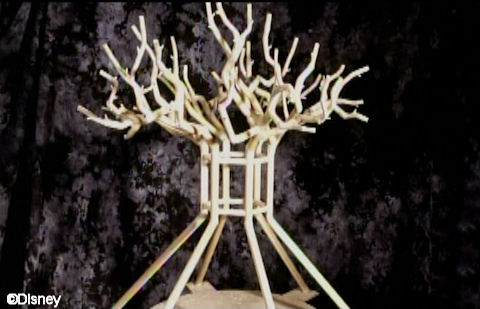
The next problem to tackle would be the branches. In order to withstand winds in excess of 74 miles an hour, it was believed that the limbs would need to be made out of a rigid, non-flexible material, like steel. In addition, in order to make the project cost effective, the branches would need to be mass produced. This would dictate that limbs of equal size be of identical shape. However, uniformity is not found in nature. When wire-frame drawings and artist renderings were completed, the tree resembled an inflexible geodesic dome more than a glorious tree.
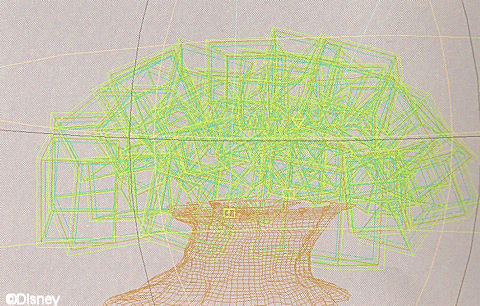
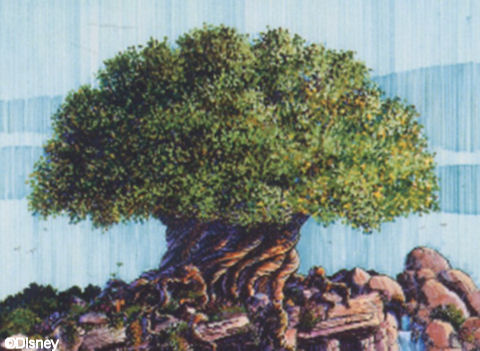
To solve these problems, the Imagineers first developed a flexible, injection-molded fiberglass to create the branches. These would range in size from 2-feet in circumference at the trunk of the tree to 2 inches where the leaves would attach at the end. And since the material was flexible, the limbs would move in the wind, just like a real tree.
Next, a way to attach identical branches in a random pattern was needed. To resolve this problem, 32 balls were created and secured to the tree. From each ball, one or two secondary branches could be attached in various positions. Special expansion joints allow the secondary limbs to move when a breeze passes through. From these branches, smaller, tertiary boughs could be attached, twisted and turned to create a natural shape. In some cases, branches would be omitted from a “standard” socket, in an effort to create a more chaotic appearance. When completed, the Tree of Life had 12 primary branches, 45 secondary branches, 756 tertiary branches, and 7,891 end branches. The tree stands 145 feet tall and is 165 feet across.

It’s interesting to note, the final design and shape of the Tree of Life was based on a specific bonsai tree the Imagineers discovered at an early Epcot International Flower & Garden Festival. I don’t know if this following picture, taken at this year’s event, is the same tree, but it certainly reminds me of the Tree of Life.
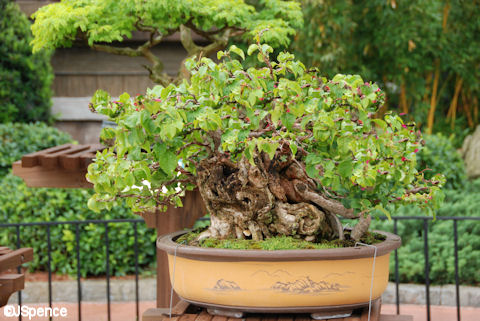
This next picture shows rows and rows of identical limbs that would eventually take on a natural design.
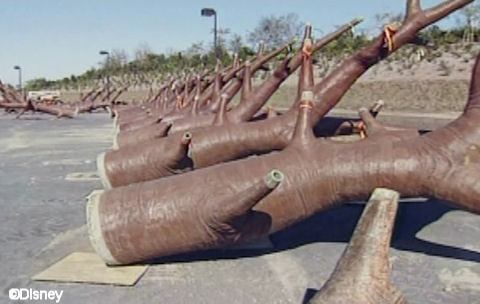
The Imagineers worked with outside firms to develop a natural looking leaf that would withstand wind, heat, cold, and moisture. In addition, the leaves could not be allowed to fade in the sun so they also needed to resist the effects of ultraviolet light. In the end, 102,583 leaves, each over a foot long, were created and attached to the Tree of Life. They come in five shades of green and they too rustle in the wind.
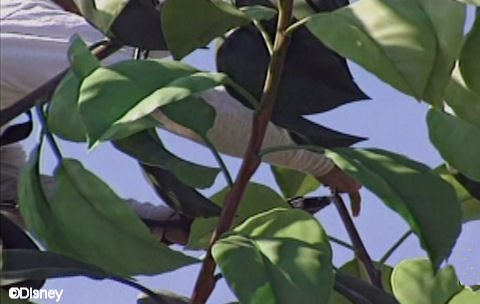
The branches and leaves were assembled on the ground and then lifted by crane into place.
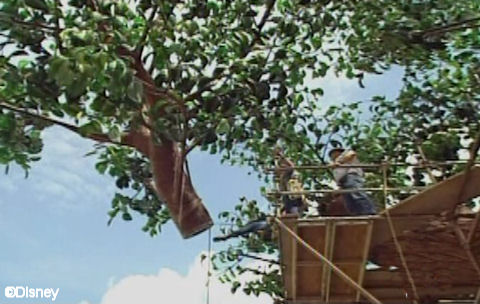
Of course, the real fascination of the Tree of Life is not the tree, but the over 320 animals that are carved into its trunk. To create this work of art, an international team of artists was assembled. Those not already a part of the Disney team all had their own studios and had proven themselves in various media in advance of the project.
The tree’s skin began as a half-inch to the foot model that featured no animals. This model only duplicated a rough approximation of what the Imagineers wanted to recreate in real life. The model was then cut into 4″x4″ sections. Each section was then scored in 1 inch intervals. A stylus was run along the scoring and the information recorded into a computer. This data was next sent to a rebar-bending machine that recreated the shape in actual size. Finally, the rebar was attached, piece by piece, to the trunk of the tree and welded into place. The attachment of the rebar took 12 weeks to complete.
Next, the rebar was covered with metal lath, a chicken-wire type material. This would act as a skin to which concrete would be applied. Both the metal lath and the initial coat of concrete can be seen in this next picture.
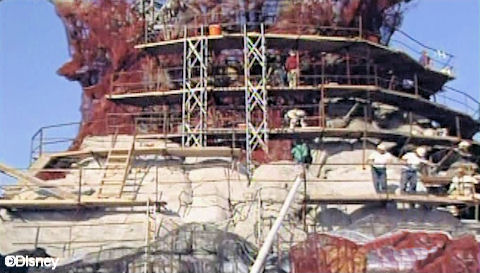
Scaffolding, approximately six feet wide, circled the tree on multiple levels. This would provide the artists with a place to work their magic. The animals were carved out of a special plaster-like cement that was applied at a depth of 2 to 4 inches over the first layer of concrete. The artists worked from the top down and each could complete approximately a 6 to 8 square foot area within the 6 to 7 hours the concrete was soft enough to sculpt. This would equate to roughly one average sized animal.
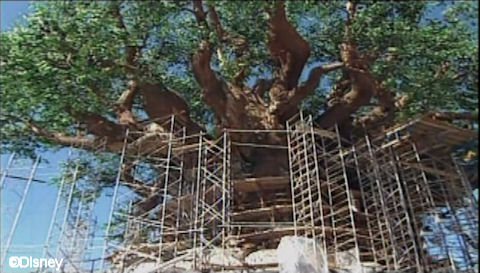
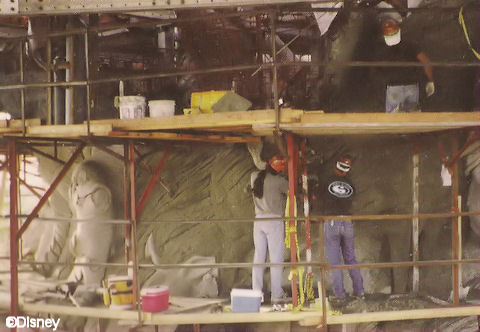
Coloring and texture was also a consideration. Various shades of browns and greens were used to create shadows and depth. When the painting was done, a final coat of polyurethane was added to shield the figures from harmful ultraviolet rays which would fade the paint.
For texture, three types of tree bark were emulated when creating the various animals: banyan, oak, and cedar. Samples of each were kept nearby for the artists to study. For example, the stripes on the tiger resemble banyan bark while the octopus’ skin is modeled on oak.
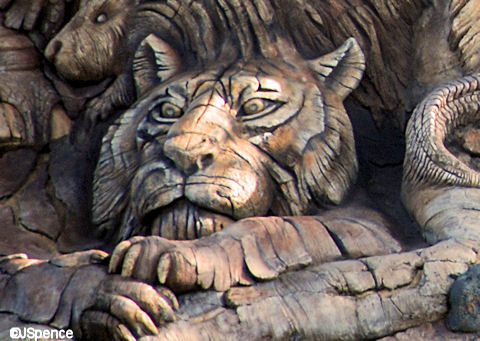
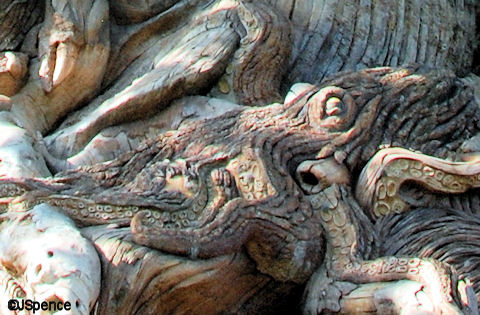
No particular scale was used when adding the animals to the tree. For example, in this next picture we see an ant as large as an ape’s face. Yet despite the disregard to size, the animals all seem to blend together seamlessly.
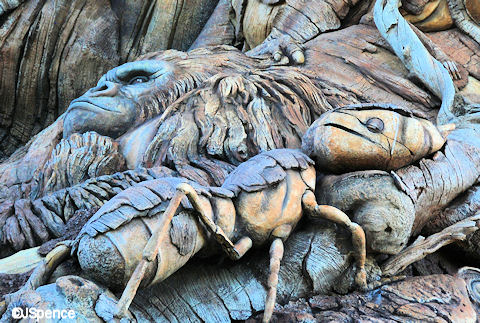
It took a team of ten artists and three Imagineers working full-time for 12 months to complete the carvings. In all, the Tree of Life took over two years from the beginning of construction to its finished beauty.
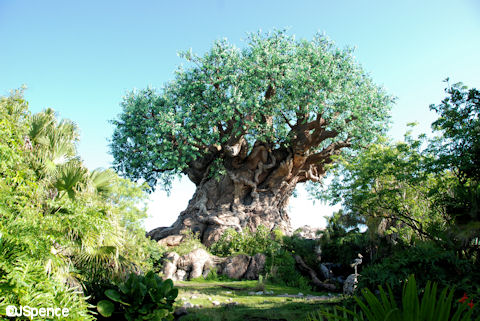
Now that I’ve given you the real story of the Tree of Life, let me give you the Disney Legend — a story to tell those who want to believe in the magic.
Once upon a time, no vegetation would grow on Discovery Island. There were no trees, no shrubs, no flowers, nothing. It was a barren piece of land. Then, one day, a tiny ant planted a seed and made a wish. He asked for a tree to grow — a tree large enough to provide shelter for all the animals. Magically, the ant’s wish came true and a tree began to grow — and it kept growing until there was room beneath its limbs for all the animals from A (ants) to Z (zebras). And as the tree continued to reach for the heavens, the images of all the animals that took shelter beneath its shade appeared on its trunk, roots, and branches.
The Tree of Life is a magnificent structure. I never tire of looking at it. And to show what a fantastic job the Imagineers did at creating this work of art, I recently heard a teenage girl ask her parents if the tree was real (alive). Although I chuckled to myself when hearing this question, the girl’s inquiry was sincere. What better complement could someone pay the artists who created this icon for the Animal Kingdom?
Next week I’ll discuss the “It’s Tough to be a Bug” attraction that lies within the roots of the Tree of Life.




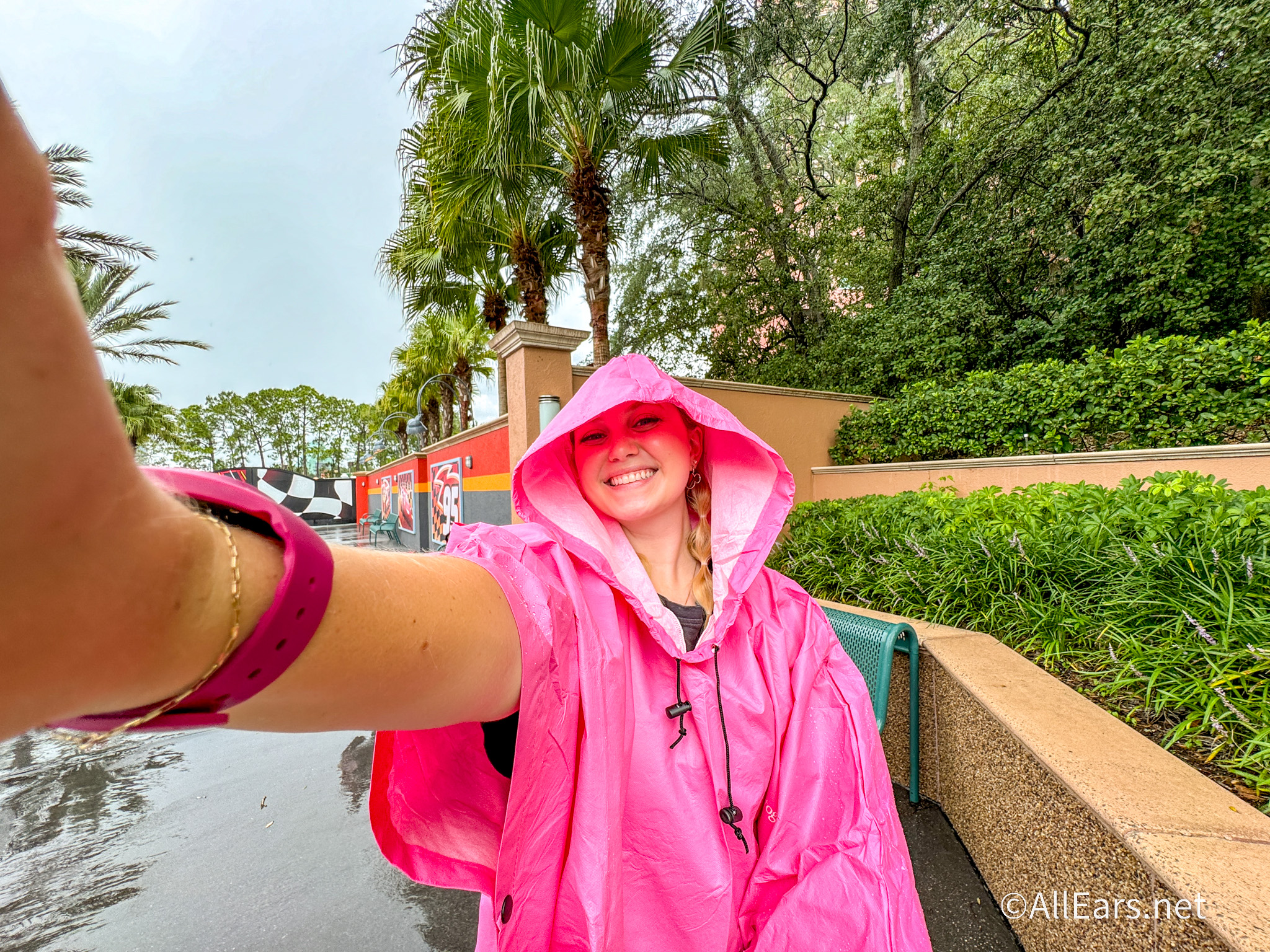





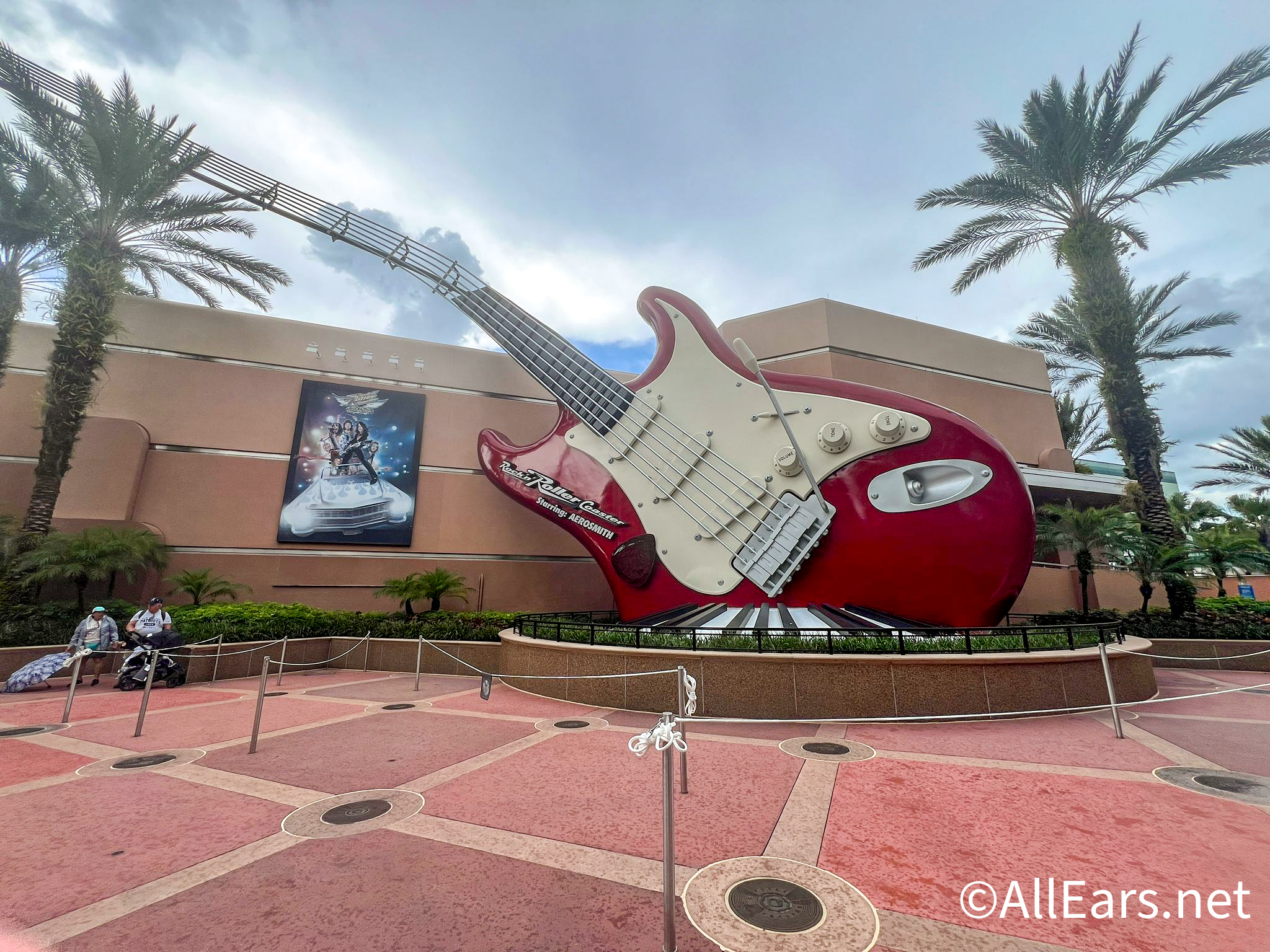









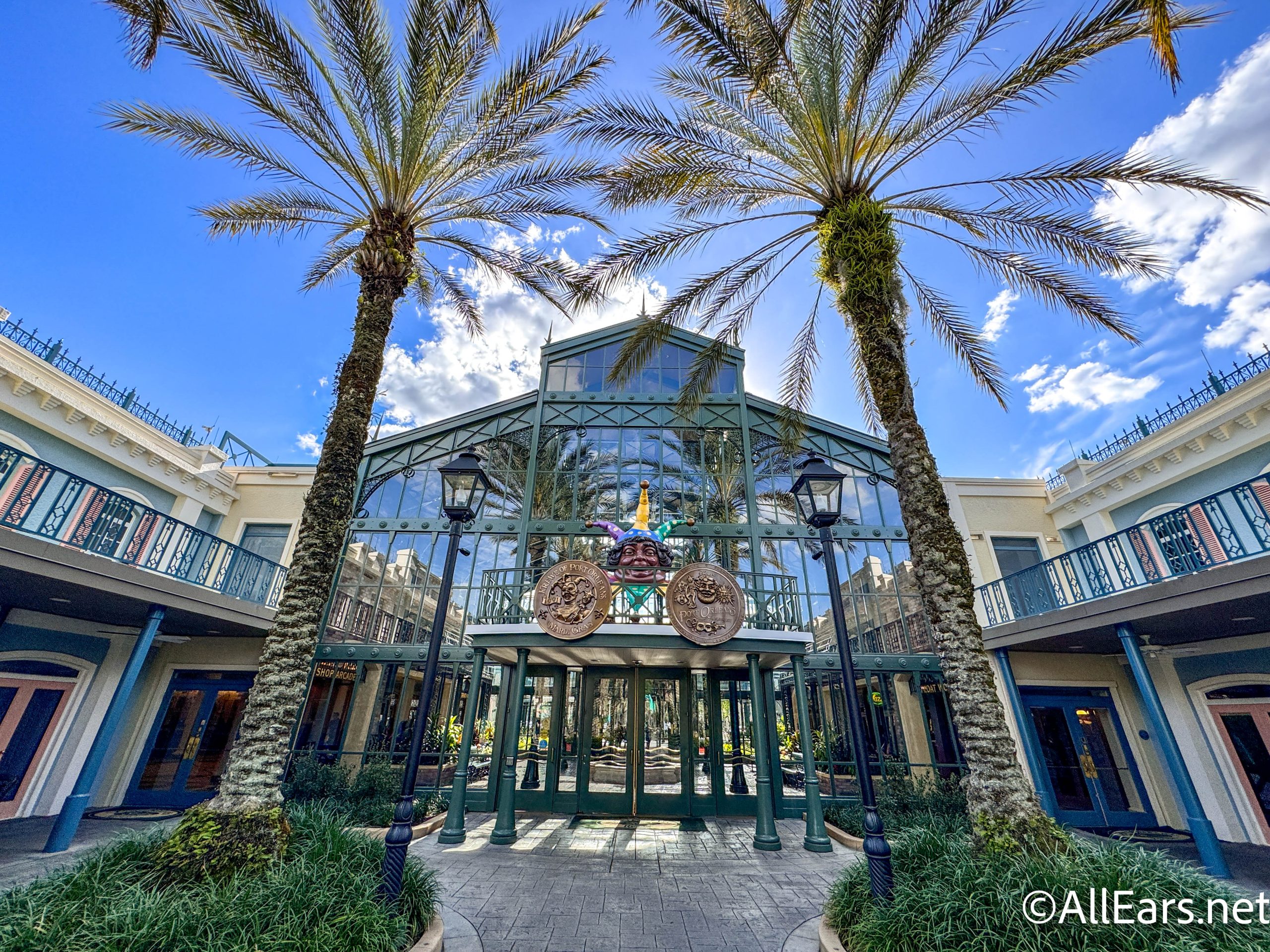


I was responsible for contracting for and building the structural members for the entire tree, including the base frame in the trunk, the roots, and all the branches. It was not an offshore drilling platform, it was a custom preliminary design and we had to use a home grown special 3D modeling program to complete the engineering and ensure it could be accurately cut, fit, welded and test fit to guarantee meeting tolerances of +/- 1/4″ out as the branches extended out and subjected to bending and thermal expansion. The trunk sections were 36″ diameter x 2.25″ wall thickness pipe sections rolled from steel plate on our rolls, and had flanged connections to allow each finished piece to be pre-assembled in my yard, test fit, and trucked from Houston to Orlando. Disney was told by a special robotics pipe cutting machine maker that my fabrication operation was the only one in the world that had this special computer capability to engineer and cut the numerous miter cuts required for this tree branch design. Disney was so pleased with the outcome that they gave me a golden and black Onox Mickey Mouse watch in appreciation and told me that of all the contractors they ever worked with, no one treated them more fairly than I did. At that time we were still a major builder of permanent offshore production platforms which started in 1947 after building 347 ships for the Navy during WWII. Our workers never could show their families what they build, so I saw this as an great morale booster and my parent company, Halliburton, while first skeptical that I contracted for this type of work, later saw it as a great PR opportunity. I was the General Manager, Brown & Root Energy Services, Western Hemisphere Fabrication Business Unit located at the Greens Bayou Fabrication Yard on the Houston Ship Channel. John Katok
Just returned from first visit to Disney. Was fascinated by The Tree of Life. Loved reading the history of it here. One question – this tree is such an amazing piece of art – why can’t I find any prints or models of The Tree of Life? I would like to buy something for my husband’s office but can’t find anything! Not even at Disney. Any suggestions?
Jack’s Answer:
When the Animal Kingdom first opened, Disney offered several replicas of the Tree of Life in several sizes and varying amounts of detail. However, like with all merchandise, these items eventually passed their popularity stage and were discontinued. I would suggest eBay.
I always thought it came from the Disney cartoon the Gummi Bears. http://www.newgumbrea.com/imagesearch/g1223.jpg-Gummi-Glen-Tree.html
Any gummi bear references in animal kingdom?
Sean
Jack’s Answer:
Nope. Not the Gummi Bears. And I don’t know of any references to them in the park.
Wonderful article loved all of the pictures and the magical ant story too. The tree of life is beautiful and I love looking at the pictures I have of it from my trip to the World.
Thanks for your wonderful and informative articles.
Great article as always! Your blog is my favorite …. are you back as a regular blogger or still doing special ones?
Jack’s Answer:
Yes, I’ve been back “full time” for a year now. My blogs appear every Monday.
Fascinating! Thanks for the wonderful article.
All kinds of cool info here, Jack!
How fitting that something blamed for so much destruction (gulf oil drilling) can also be used to symbolize the environmental message of DAK. Cool stuff I never would’ve learned elsewhere.
Thanks for writing,
Dan
Hi Jack
I always look forward to your posts. I love the tree and never tire of looking at it either !!!
I have always wondered how birds are prevented from buiding nests in the carved bark. I have looked for nests and never have seen any. Do you know if anything is done to keep the birds off the tree ?
Jack’s answer:
That’s a great question. A question for which I do not have an answer. But I do have a guess.
Nightly, Disney uses high-pressure steam to pressure wash all of their walkways. Buildings are also occasionally pressure washed as mold is a problem in Florida. In all probability, the Tree of Life is pressure washed on regular basis to keep the mold from growing — and also to dislodge any bird’s nest.
Hi Jack
I loved your Blog. What wonderful information some of which I did know. The tree is such a work of art.
I’am all for the Hat move in Hollywood Studios also!
Can’t wait to read next week.
Thanks for the work you do.
On another note did you ever do a blog on the rooms in Animal Kingdom Lodge not the vacation club just the regular and savanna view ones?
Jack’s Answer:
I have never written a blog about the standard rooms at the AKL or Jambo House. I’ve only covered Kadani Village. But it’s on my list of things to do.
Hi again from Buenos Aires Jack!!! I wrote you for last time a long time ago, and I was trhilled when you started to blog again!! I love all you write, but the last two blogs about Animal Kingdom deserve a big THANK YOU!! I love discovery trails and tree of life, I love the walks too! a lot of my friends say they are boring bu I love them, and I´m not a animal person. I think the Disney touch in them is so powerful that even a city person like me get into it. I loved read your blogs! read you tomorrow!
I am always fascinated by the Tree of Life. Does anyone know if there is a catalog, diagram, or just a list of all the animals on the tree?
Jack’s Answer:
I have never heard of any diagram or catalog that is available to the public. I’m sure the Imagineers have some sort of record as to what animals were created. Maybe if you stop by Guest Relations sometime, they might have more information.
Hey Jack,
Another great blog! The Tree Of Life and Discovery Island are GREAT places to wander through and around.
I knew the story of how the tree was built from before, but now I also know the Legend behind it.
Thanks!
Hey Jack,
Yet again what a wonderful blog. I always enjoy the detail and how much I learn reading your blogs. I wanted to tag in to say as well that I hope that they quickly remove those new protective coverings they placed under the tree and around the trails. They truly do take away from the atmosphere and IMHO is a poor “band-aid” of a solution. So for the upper managerial CMs that read your blog please find a better solution to the problem soon and remove the unsightly protective coverings. And while your at it move that Hat to! I greatly dislike how it obscures the Chinese Theater. I like Jack’s idea to move it to the front of the park. In addition I think you should hire Jack as a paid consultant! There I said it:)
Rob
My 7 year old asked me in March if the tree was real. Honestly, I didn’t know myself. Guess you can giggle at us too. Great informative article!
Jack, this was a great blog. The engineer in me just loves the idea that someone took an oil rig – existing technology – and turned it into one of the most beautiful pieces of art I’ve ever seen, one that inspires and delights anyone who lays eyes on it. That, to me, really is magic come alive!
I have one question. You often have pictures of Disney concept art, early models and the like, just as in this blog – often these early concepts are not much like the end result. Where do you find these images?
A.D. Johnson
-Littleton, CO
Jack’s Answer:
I have several books that contain Disney concept art, however, I find most of it on the internet.
Hi Jack!
We’ll be running down to AK tomorrow. We’re planning on spending a good anount of time just relaxing on Discovery Island and walking the trails.
I love the backstory on the Tree of Life. The story is fitting (or should I say the name is fitting) for the name of the tree. The island was barren, but after the seed was planted and the “Tree” grew, it gave life to all the
living things we see on the island today. At least that’s how I like to think of it….
It was great seeing you and Deb the other day. Hope to see you again sometime soon.
Take Care,
Johnny
Of course, nothing about your story of the fabrication of the tree makes the Disney Legend untrue. Disney has been in the granting wishes business for 80 years!
Great Blog, Jack!
So much info packed into an entertaining story. Well done.
the afternoon after hearing Jim Korkis speak and went over AK check out the paths around the tree lot of pictures after the 2nd time around stop and slice of pizza at pizzaari then went back but this time did tough to be a bug i think i spent at lease 2 hrs. love the story about the building of the tree thanks tom
Jack – as always, another wonderful article! Animal Kingdom is one of my absolute favorite places in the World or the world, and the Tree of Life is a glorious icon. I think it is an incredible example of human engineering and the creative spirit and how they can be combined to produce wonders.
hey jack
the tree of life is one of those icons that is always amazing to look at not only from far away but up close as well. there are so many details in the tree especially with the different animals that were carved out of the wood. can’t wait for your next blog and as always keep up the great work.
Interesting to read how the Tree of Life came to fruition. Do you think the recently installed protective netting over the trails will be permanent? Let’s hope not! I understand the legal reasoning behind it, but it really takes away from the beauty of the trails winding around the Tree of Life.
Jack’s Answer:
I agree. The new protective covering takes away from the overall appeal of the trails.
I don’t know if the covering is permanent or not. It has a semi-temporary look, but it also has a semi-permanent look. Only time will tell.
This was great! We visited for 1st wdw trip in 2010. AK was first park and I was so excited to see the tree. I’ve read how they built it, but seeing the still pics help envision. Thank you esp for the telling of the legend! i will share w the kids when we return in ’13. Many magical wishes to you!
Great story about the Tree of Life’s conception and construction. All things I didn’t know. Thanks Jack!
P.S. – I’d pay real money to see that silly hat removed from DHS and the restoration of the Earful Tower as the icon there. It is the most egregious remnant of the waning Eisner years.
Jack’s Comment:
I’d also chip in to have the hat removed/moved.
Actually, I like the hat. I just hate where they placed it — directly in front of the beautiful Chinese Theater. I wouldn’t mind it at all if it was moved out front of the park where the flagpole is located. I think it would look great there and a nice way to great guest arriving at the park.